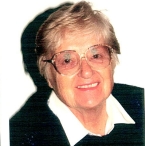
Treasures - 2003
by Ruth Stahl
Click For 2004 Articles
Click For 2002 Articles
Click For 2000 Articles
Could You Do All Your Holiday Shopping On the Island?

December 4, 2003 . . .Maybe you could. Except for major appliances and high-end clothing. Just take a look around the next time you are running errands. For instance, the Post Office. You can buy a cute little bank, made like the storage receptacles you see on the corner, for just $4.95. If you have a pet lover on your list, you can choose a dog or a cat, enlarged, with a first day cover of the related stamp. Matted and framed, these are just under $20.00. My favorite is the framed teddy bears, along with the stamps, but the price is $49.95. Available also are notepads, canvas bags, bears, and even hats. Give the merchandise the once over the next time you find yourself standing in line.
My next stop was the hardware store because I needed a piece of glass. I’m framing an old piece of lace for a gift. You can always buy tools like a Black and Decker cordless drill for $29.95, but check out the clever detailed bird feeders of oiled wood. There are birdhouses and even a bat house for $29.59. Andy Rooney loves browsing in a hardware store, and you will, too. I found my favorite item at Grand Island Optical, and no, it wasn’t a pair of glasses. Lou Macro has some beautiful glasses holders, hand made beaded ones with sterling silver fittings. There is a ring at the bottom of the necklace to hold your glasses by the temple piece. These were $39.00. I also liked the magnetic clip on sunglasses. No fuss or bother.
I can’t go out shopping without a stop at Rite Aid for pills. Besides perfume and all the usual stuff, you can buy a 5” portable T.V. for just $39.99 or a Karaoke Machine for $49.99 there. What fun everyone would have with that! Next, I went to the garden center for a wreath and was surprised to see all the gift items available. (Christine Ryshkus does beautiful china painting and has hand-painted porcelain ornaments for sale. She is speaking this week at River Lea.) I saw beautiful hand blown glass from Czechoslovakia and Buyer’s Choice figurines, especially the Williamsburg carolers. There was also a selection of linens and tee shirts. Currently all gift items are 30% off.
Would you believe I went to Fuccillo Chevrolet to see if they had anything under $100? I for sure wasn’t planning to buy anyone a new car, but did see some beauties. The service manager wasn’t really enthusiastic but offered an oil change for $26.95, a tire rotation for $18.95 or a complete detailing for a car for $99.95. None of these thrilled me. For contrast I checked out the two dollar stores on the Island, a great place for toys and Christmas items. I fell in love with a little shadow box containing a bathroom scene, with an old fashioned bathtub, a little shelf for soap and cologne, a hanging towel, and even a pair of slippers, all in three dimension. I found two different scenes and will hang them in my bathroom. Just $2.00 each at Family Dollar. (See photo above.)
What could be better than chocolates from The Chocolate House or Kelly’s Country Store? We have two liquor stores if you are looking for a special bottle of wine, Colonial Liquor and Rose Liquor. At deSignet Jewelry on Whitehaven you can buy exclusive Island shaped charms in four sizes from $15 to $25. Included in the price is conversion to pins, cufflinks, pendants, tie tacs, etc. They are also available in 14 K gold, for up to $149. Celtic jewelry is really hot right now. You can buy a Celtic necklace with a yellow sapphire for $184. Lots more stuff, with anything you’d like, custom made. Around the corner at Eddie’s Art Shoppe (yes, there really was an Eddie, now deceased), they frame anything and everything. Some of the items Sue has put into display frames include golf clubs, turkey tails, deer hides and sport shirts. They are still doing special orders.
Next door to the framing shop is the Sports Card Shop, but don’t let the name fool you. Step inside the door and you will see every kind of sports collectible available from nodders to Nascars to Yu-Gi-Oh cards and accessories. (I never heard of them, but they are hot right now.) Owner Jesse says people don’t know it, but he meets Walmart prices on practically everything. I couldn’t go home without checking Heatherstone Kennels for a treat for our black Lab, Bailey. The cutest thing they had was a soft snowman who played “We wish you a merry Christmas”, and only $5.99. You will see stuffed gingerbread men, red, white and blue fabric dumbbells, and for your kitty, six assorted mice for only $3.00. I ran out of energy before I ran out of shops, so if you don’t want to go “abroad”, keep your eyes open the next time you are out shopping, right here on Grand Island.
The Fine Points of a Community

November 27, 2003 . . .Although my school days are long since past, I had occasion to visit our high school twice this week. First was the monthly meeting of the River Lea Quilters Guild. You might think that all these people do is sew, but that is not the case. Hazel Rowe heads up a group that has made at least three dozen Christmas stockings, which they will fill with goodies and give to the Neighbors Foundation for the holiday. Another group sees that small quilts and lap robes reach hospital patients and residents of the nursing home. Many quilts were sent to a hospital in Nepal this year. Rita Rosene and Clemens Fair are working on the decorations for the bedroom at River Lea. (Remember that River Lea will have open house on November 30 and December 7 with special luncheons on the 2nd, 3rd, and 6th of December.)
In addition to all of this, Judy Buzby is the chairman of our upcoming quilt show, to be held in the spring at the middle school. Besides all the beautiful quilts members are working on, there will be vendors and demonstrations. There will also be theme baskets to be won by lucky ticket holders. Somehow I got assigned the task of filling a basket with doll stuff, and I am going full steam ahead. So far I have dolls and doll furniture, books, patterns, and other little miniatures. It promises to be a great show so be sure to reserve the dates ( May 1 and 2, 2004).
At every meeting there is a guest speaker discussing old quilts, new quilts, patterns, sewing machines, and something new this month, beads. Currently beads and ribbons are used extensively to decorate quilts, especially wall hangings. The owner of the Bead Gallery on Main Street in Snyder showed slides of all the different kinds of beads and gave valuable hints of the kinds not to use. If you need beads for any purpose, check her out at 3963 Main Street. My niece makes beaded items for reenactor events so I know she will be anxious to visit. I have another friend, too, who makes all manner of beaded items.
There is always more at a quilters’ meeting. Every month many members make a 12” block of a specified color. Piled together they are raffled off and the winner usually has enough to make a quilt. Ken Beagle won pink and red blocks in February. He got a few laughs but put together a delightful quilt for his granddaughter. Last December I won the red and beige blocks, which I recently sewed together. I took it to Log Cabin Quilters here on the Island for machine quilting, and let me tell you, a beautiful job was done. Joan Staub treated it as a sampler quilt and put a different design in each block plus a border of apples all around the edge. You’ll see it at the quilt show.
“Show and Tell” is one of the highlights of the meeting with members showing off their completed projects. Betty Bursik finished another beautiful crazy quilt and Maire Machens displayed her Santa table runner, finished at the last Saturday workshop. Jesse Tromanhauser showed us his aunt’s heirlooms, which recently came to him. He had a beautiful appliqué kit quilt, all ready for quilting, some old basket blocks, a beadwork garment, and a crazy quilt. It was great to see all that vintage fabric. The guild is open to all, whether you quilt or not. Usually every month a workshop is held on Saturday at the high school, helping members complete another project. Meetings are held on the third Tuesday of every month.
The other meeting I attended was the committee for adult education, or I should say Community Education. Jenepher Banker is the director of that program. She reported on the fall semester and presented a tentative catalog for January. Some of the most popular programs this past fall were painting, quilting and knitting, golf, cardio kick, American boating, driving, archery and basketball. Hall-walking had one of the largest enrollments, probably because it saves a trip to the mall in winter and is available every week night from Monday to Thursday. Altogether 930 students took part in 114 courses. Most of the programs are self-supporting with no cost to the taxpayer. The new catalog will show up in your mailbox soon, so you might like to pick out something interesting for those cold winter evenings. Classes start on January 26, 2004 and are discounted for senior citizens.
Noted here are just two organizations that help make life better on our Island. There are many more if you look for them.
Spicer Creek
November 6, 2003 . . .Many called it “Spicy” Creek years ago, especially the neighbors on East River near Whitehaven. “In summer we caught sunfish here and picked wild raspberries and strawberries along its banks. During the winter we went ice skating. It was wider then, but we could still cross on a fallen tree. We often cut over the creek to reach Electric Beach where we rode on the Bumpety-Bumps,” one old timer told me.
Spicer Creek begins somewhere south of Grand Island Boulevard. From Staley and Stony Point it angles to the northeast, meeting Whitehaven Road near the River Oaks Golf Course. The creek crosses East River Road next to Whitehaven Cemetery, bordering the property on its route to the Niagara River.
How did Spicer Creek get its name? There is no record of a Spicer buried in any of the Island cemeteries, and no such name in the census records of 1855 or 1892. The 1870 census shows a Thomas Spicer, age 79, born in England, and his wife Christina, both living with a family named Griswold. Perhaps Thomas Spicer named the creek in his earlier years.
Rob Roy MacLeod reported in his book, “Cinderella Island”, that a survey completed in 1825 by Silas Kellogg and James Turner showed names of all creeks and islands as they are today, with the exception of Motor Island. That same survey indicated that someone named Spicer lived in the vicinity of Fix Road and Alt Boulevard. Could he have named Spicer Creek?
Islander Paul Reger enjoys Indian lore. “The area behind the golf green that is closest to Whitehaven Road and the creek was the main summer campsite of the Late Woodland Indians, dating back to 1500 B.C. The creek was a source of water, fish and waterfowl, besides being a good place to trap small animals. Strangely enough, the Indians camped closer to the River in the winter months,” he said.
Spicer Creek leads naturally to Whitehaven Cemetery, one of the prettiest and most peaceful spots on the Island. I went there in the spring when the flowering crab had just come into bloom and the larger trees had just recently leafed out in the freshest of greens. Warm sunshine and a gentle breeze added to the charm. I had come to choose a final resting place for Pop, whose ashes had remained too long in the cupboard. I had originally thought to scatter them on the water, but lately have come to the conclusion that my nieces and nephews needed a place to commemorate the life of their grandfather. I thought Pop would like his plot near the road, not too far from Spicer Creek, no matter how it got its name.
School Memories
October 23, 2003 . . .Moans and groans may accompany the return to school in September but, I think in most cases, it’s just an act. School is hard work for some but it provides challenges, stimulating experiences and discoveries, and the companionship of classmates. When adults are asked about early days at school, memories are varied and sometimes curious, but they must conclude that school days were some of the happiest times of their lives.
Betty Clement told me, “It was exciting. I got new clothes and a new pencil box and crayons and notebooks. I liked going back to school.” Another resident said, “I was an only child so the companionship of my classmates was important.” Bob Stahl felt the same way. He enjoyed his school friends and the social activities.
Joan Bodkin remembers first grade clearly. “I had to climb stairs outside the school building. For some reason my mother hadn’t taught me to use alternate feet on the stairs, so I took one step at a time. One day the teacher took my hand and walked me down the steps. I’ve been doing it right ever since,” she laughed.
Martha Mazzarella attended a little red schoolhouse near Peekskill, a very historic area. It was just for kindergartners and hers was the last class in that building. Soon after, it became the home of the local historical society. Martha’s mother, Patricia, helped establish the society and made one of the blocks for its first raffle quilt. Pat is now a compulsive quilter and barely remembers that first schoolhouse block.
Heber Ashley, Sr. was a highway engineer and involved in building Island roads as well as approaches to the bridges. He was also on the Board of Education for many years. His daughter, Yvonne, went to School #5 at Bush and Baseline for grades one to six. She once told me, “I remember our teacher, Miss Guenther. There were lots of DeGloppers at school, and Santos, and Dan MacNamee was in my class. My father told me not to fight with anyone because they were all related. I remember playing a trumpet duet with Henry Killian at the dedication ceremonies when the bridge opened in 1935. I went to school #9 for grades 7-8 where I had a terrific teacher, Miss Grenzebach. There were only eight kids in my class there.”
One of Doris Rees’s bad memories is going back to school in September after a long illness. “I had to walk a mile and a half to school and was exhausted when I got there,” she said. (She doesn’t have any trouble traveling with the Golden Age Club these days!)
I’ll never forget what the late Mabel Leibinger told me about her school days. “I always had butterflies in my stomach when the first day of school arrived. We had to walk two miles to school, but sometimes we rode on a light one-horse wagon that took the milk to the condensory. Then we had to take the horse and wagon to my grandfather’s barn and run the rest of the way to school. We had a one-armed janitor who could always hear us coming. He would hold up ringing the gong because if you were late, you stayed an extra hour after school. We ran like Billy be damned!” she said.
These are just a few school recollections. What do you remember?
Elroy’s Story
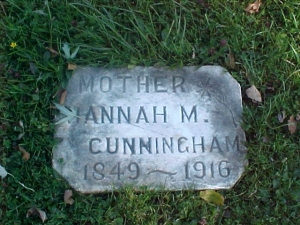
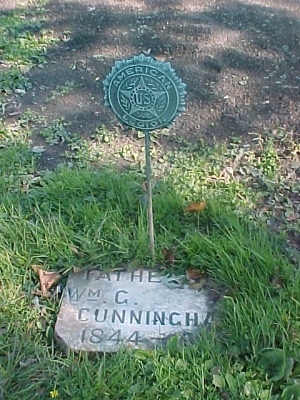
October 9, 2003 . . .Elroy Klahn of Tonawanda was a man with a mission. It started simply enough: he wanted to know how he was related to neighbors of the same name. He found they had common ancestors and in the process became hooked on genealogy. That took him, armed with a shovel and a screwdriver, to Grand Island and the time of the Civil War.
Elroy’s great-grandfather was Fred W. Cunningham of Grand Island. It was thought he owned a farm here at one time, but Elroy could find no trace. He contacted Maisie Dommel, past president of the Grand Island Historical Society. Maisie referred him immediately to Bernice Gibson and Nancy Schiffhauer (now moved away) of the Grand Island Genealogy Society. Bernice and Nancy turned up important information right away. In a volume of 1898 called “Our County and its People”, by Truman White, they found a lengthy reference to William G. Cunningham.
He was born in 1842 in Kentucky, orphaned at the age of six, then taken in by the McGregorys of St. Catherines, Ontario. He came to Grand Island in 1860, enlisting in 1861 in Company A, 44th N.Y.Volunteers. Only one man from each town in Erie County and each ward of the City of Buffalo was selected for this special company known as the Ellsworth Avengers. Each had to have $100 for two sets of uniforms and a rifle. Cunningham served for three years under McClellan, Burnside, Hooker, Meade and Grant, fighting in many major battles, among them, Yorktown, Second Bull Run, Fredricksburg, Gettysburg and the Wilderness. He was wounded at Gettysburg and in the Battle of the Wilderness. Later he farmed on Grand Island, worked in the oil fields of Pennsylvania, and then became a steamboat engineer on the river and Lake Erie for 14 years. He bought a farm on Grand Island and married Hannah Maynes in 1869. They had one son, Fred, and another, John, who died in infancy.
Elroy was sent next to the Erie County clerk’s office where he found Cunningham’s will. His farm was valued at $3000 and personal property, $800, including hay, cows, horses, a buggy, and bees. The date of death was listed as July 23, 1901, on Grand Island, and that led Elroy to the obituary in the Buffalo paper. Although William was buried from Trinity Church, there was no such record for 1901. Elroy soon found that there was a family plot, perhaps empty, right next to the parking lot, in line with the back door of Old Trinity. Elroy went to that lot with his shovel and a screwdriver. On the first thrust he hit pay dirt, something solid. Then came the most exciting discovery of his search.
He carefully removed the sod and found three perfectly preserved markers, one each for William, Hannah and John. The names are strongly carved, simply decorated with a flowering twig. Elroy has raised and leveled the stones, and had a flag placed there for the Civil War hero. The last I heard of Elroy Klahn, he was seeking his great grandfather’s pension records, and researching the rest of his family, looking for the Schwabs, the Maynes and Katherine Wetterholt. I tracked Elroy to some shirt tail relatives in Springville but haven’t located him yet. It would be great to know what else he has discovered about his family’s history.
Giant Pumpkins on East River

September 25, 2003 . . .It’s almost pumpkin time, time to decorate for fall and Hallowe’en. The stores and stands are already selling pumpkins, but that’s not the only place you’ll see them. All summer long folks have been slowing down and looking at Mike Madigan’s giant pumpkins on East River Road as they go by. Mike has some growing in the backyard, but his biggest are on the riverside, where three specimen’s weigh an estimated 150 to 200 pounds each. “They’re not big enough for the weigh-off on Saturday. With all the rain, they got a late start, and also, this year I’m establishing a new bed, “ said Mike.
Mike starts plants in pots indoors on April 15 and plans to put the plants outside by June first. The seeds are called Atlantic Giants, and Mike has been very generous in giving starts to his friends. On the island, Jim Smith, JoAnn Fisher and Dan Brown have been growing the giant pumpkins and in Tonawanda, Mark Wagner and Jim Kubiak are in the running. Mark has one pumpkin that weighs about 400 pounds and Jim has one that is more than 500 pounds. Jim will enter his in the weigh-off in Clarence this Saturday (September 27, 2003).
One year Mike had a 600+ pound pumpkin and came in 12th at the weigh-in.
I asked Mike for some of his secrets. First thing is the soil. He prepares it with lots of manure, peat moss and vermiculite. “It takes several years to build up the soil,” he says. As the pumpkins grow, he nips off all but one example on each vine, so that all the growth will go to one pumpkin. Throughout the summer he overfeeds with Rapidgrow, about every five days. He sees that the pumpkins get plenty of water.
On Friday Mike and a couple of friends will weigh the pumpkins and then carry two to places of honor on the front porch. The third will become a giant jack-o-lantern. This will all take place at his annual pumpkin party, when Mike and wife, Leslie celebrate with their two sons and a crowd of friends. There will be a big party in honor of the giant pumpkins.
Mike has been growing pumpkins for over ten years, starting at his former residence on Whitehaven Road. An old friend, Karl Kaiser, a farmer from the Mack Farm in Rush, New York originally got Mike interested. Kaiser is gone now but he would be proud of his friend’s achievement. Next year Mike promises me a couple of starter plants. I’m preparing the bed right now. Then maybe you will see even more giant pumpkins on East River Road.
Cormorants Everywhere!
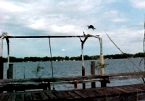


(Top) Ruth Stahl Photo; (Bottom) Nathan Cook Photos - Click photos for larger view.
September 11, 2003 . . .Every morning I sit on the porch and watch the cormorants arrive. They come by ones and twos from downriver and perch on the abandoned dock across the street. The dock has an overhead bar about 20 feet long and it is a favorite place for the seagulls to sit. They were alone until four years ago when two cormorants arrived. Two years later there were four cormorants, and now, this year, there are eight. At first the cormorants chased away the seagulls, but now they coexist uneasily. With eight big black birds stretched across the bar, there is not much room for seagulls, although a few remain to hold their space, I guess. The adult cormorants stand upright with wings outstretched as they dry them out, looking like giant vultures. By late afternoon they are gone, and the seagulls return.
Cormorants are large birds, up to 27” long and with a wingspread of 50”. They have long, thin necks, a long, powerful, yellow beak and a long tail. They have webbed feet and are powerful swimmers. They catch fish by diving underwater and can stay under for a long time. On the surface they swim with their bills pointed upward, looking quite snooty. They breed from James Bay and the Gulf of St. Lawrence to the coast of Maine and Massachusetts. Hundreds live around the Bay of Fundy in Nova Scotia and many hundreds more on islands in the St. Lawrence River. They have taken over an island in Lake Ontario; to get downwind of it is an unpleasant experience. Cormorants are actually related to pelicans and in Asia are trained to catch fish.
Islander Bill Burch, noted birder, came over to share his file on cormorants. He tells me that Buckhorn Park has a flock and there have been some around Edgewater. He also remembered seeing more than 1000 at the Buffalo waterfront. Cormorants are unpopular because their droppings kill any vegetation and they tear up plants to make their nests. It has been substantiated that they lower the supply and quality of fish. They are protected but residents have been known to shoot them when authorities are absent. The question is, how many more will come here and will they affect our Island ecology?
It’s striking to note that as late as 1995 the first successful nesting of double crested cormorants occurred in the Niagara Frontier region. Little Galloo Island is a 43 acre island 5 ½ miles west of Henderson Harbor. In 1996 a nest count of 8410 was recorded there, while in 1974 there were only 22. The eastern Lake Ontario region has the largest nesting colony in New York, perhaps in North America. Bill noted that Dunkirk Harbor is a favored spot and last August 1093 were counted at Buckhorn. Bill recorded 174 on Motor Island. Once cormorants claim a nesting habitat they destroy the foliage with their droppings and it is claimed, deplete the area of fish. Population in North America is estimated at 2 million birds.
The Great Lakes population was almost wiped out by DDT and other factors in 1960-70, so the birds were added to the protected list in 1972. They migrate to the southwest and the Gulf of Mexico but return by May to breed and rear their young. Their nests are made from sticks and twigs, built in trees or on the ground. Cormorants eat many varieties of fish, especially alewives and other small fish. Serious concerns arise when cormorants compete with other water birds for nesting sites. Because of this the taking of cormorants is allowed on catfish and bait farms. Efforts are underway to keep cormorants from establishing nesting sites on new islands in Lake Ontario and to control nesting on Oneida Lake. In 2000 the Bureaus of Wildlife Resources “oiled” eggs, reducing reproduction by 97% on that site. They also removed over 1300 nests from other islands to prevent the establishment of new colonies.
There is a lot of controversy about cormorants. The Federal government is considering a plan to allow sportsman to take 200,000 birds a year, but so far, only the DEC is allowed to destroy eggs and nests. Locally, conservationists are afraid the cormorants will make a barren desert of Motor Island, a fragile habitat as it is. I have enjoyed watching them this summer, but they will soon migrate to points south. They will probably return in even greater numbers and the controversy will go on.
Blackout: Now and Then
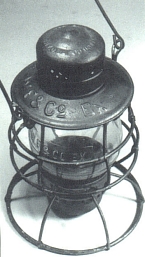
August 21, 2003 . . .Where were you when the power went out? It happened around 4 p.m. last Thursday but affected only the Northern and Eastern parts of the Island. It was early enough to finish reading the paper on the front porch but too early for fixing dinner if you had an electric stove or counted on your microwave. We have a gas stove, so I could cook by candlelight, but I sure missed my microwave oven. Local restaurants reported a surge of business around dinner time---all those folks who couldn’t cook. When the power returned at about 9:30 p.m. I was all out of the notion of doing anything, so went to bed early. We were lucky to have such a short period with no power.
On September 5, 1901 the Niagara Falls Gazette carried an ad that stated, “The Buffalo and Niagara Falls Electric Light and Power Company is prepared to furnish current for lighting, heating, and power purposes in large and small quantities. For particulars and terms, apply at office, No. 7 Falls Street”.
The same issue reported a convention of municipal electricians that had lasted three days at the International Hotel. The daily news included the information that all passes to the Power House of the Niagara Falls Power Company were to be suspended during the upcoming visit of President McKinley.
There was a lot of talk about electricity in 1901, but there was no power from the Falls on Grand Island. In his book, CINDERELLA ISLAND, Rob Roy Macleod states that telephone service to the mainland was established in 1902, but electric service was not generally available until 1922. That date seems to be just about right.
Some residents remember swimming at the Power Company dock at the end of Long Road, where supplies and equipment were unloaded. Steel towers were being built to carry the lines across the Island, and local farmers with their teams of horses hired out to move the steel from the dock to the worksites. “Folks could hardly wait for the power to come. Our gasoline powered wash machine had finally quit and my father didn’t want to repair it because electricity was just around the corner,” said one long-time resident.
It was a grand day when electricity became available but there were still poles to install and lines to string before every home could enjoy it. And not every homeowner took advantage of the new service, as it was another expense. A resident of Ferry Village remembered that lines were strung on her street in 1923 but they were still using oil lamps in her house.
Not too long after the towers went up, a severe winter storm caused several to collapse, disrupting service for quite a spell. “Thank the lord we saved our oil lamps,” said my storyteller.
The late Jim Cook of Falls Link Drive told me that when he was about six years old and living on the West side of Buffalo, many streets had electric lights at the corners but gas lights in the middle of the blocks. The lamplighter was still performing his duties and that was one job Jim wanted in the worst way. “The lamplighter had a long pole with a hook on it for opening the valve that controlled the gas flow. There was a pilot light so he didn’t actually have to light the lamp. During the day he went around with a ladder, cleaning globes and repairing mantles. The mantles were delicate filaments that improved combustion and gave a warm glow to the flame.” Jim remembered all this activity taking place in the vicinity of Front Avenue (now Busti) and Seventh Street.
Later on Jim worked at the Bedell House, where a gasoline-powered generator supplied the electricity. He said you could tell when the generator started working because the lights got brighter and brighter until full power was reached. Likewise, when the current was winding down, the lights dimmed and finally went out. Naturally, there were candles and oil lamps for back-up lighting when the generator failed.
During World War I, Jim was in the Boy Scouts, and he recalled making “trench candles” for the war effort. These were made of rolled up newspaper, tied and soaked in hot wax. When lit they lasted a long time and could be used for light or as a fire starter by our men at war in Europe. He said school children made them, too.
Just think of all the appliances and computers that run by electricity today. All we have to do is flip a switch (and pay the electric bill). Of course, it’s pretty much the same when the power goes out, either now or in the good old days.
Lighting Up
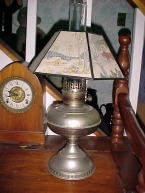
August 14, 2003 . . .On the day he was shot, President McKinley took the train from Buffalo to Niagara Falls to do some hiking and sightseeing. After a big lunch at a local hotel and time taken to smoke a cigar on its front porch, he visited the new power station, built in 1896. That station provided the power for over 200,000 electric lights that were one of the main attractions of the Pan American Exposition. The Niagara Mohawk Building on Washington Street in Buffalo was an attempt to copy the Exposition’s Tower of Light, lit by thousands of bulbs.
Thomas Edison is the fellow that started all that when he invented the electric light bulb in 1879. It took a long time for electricity to reach the common household, so the lights that folks saw at the 1901 Exposition were merely an indication of luxuries to come.
Most homes at the turn of the century (from 19th to 20th) were lit by oil lamps of various kinds. They ranged from simple hand lamps to elaborate chandeliers, and they all had to be filled with kerosene and have their chimneys polished daily. I remember my mother doing that when we first moved to the country before the power came down our road. Before 1850 smelly whale oil lamps provided the household light, a definite improvement over candlesticks. Candlesticks have been around for hundreds of years. Some simple early ones were attached to a sharp spike that could be driven into any convenient beam. Others had slotted sides for moving up the candle as it burned down.
Grease lamps were used before candles were devised. They are sometimes called Betty lamps or cruises and consisted of a rope or rag dangling out of a dish of grease. The dishes were often double so that drips could be salvaged. They had hooks attached for hanging. Early ladder-back chairs can be found with scorch marks on one of the ladders where grease lamps were conveniently hung.
Having the means to light a candle was important in early days. In Boswell’s London Journal, he reports that he accidentally put out his candle one night and had no tinder box to relight it. He spent hours in the dark before he found a passer-by to give him a light. I can just hear you saying, “Sounds like Grand Island when the power fails.” That’s when we all go back in time and light a candle or an old oil lamp. Actually it wasn’t that long ago that electricity came to Grand Island.
One resident, now deceased, remembered that in 1912 there was no electricity in the family homestead, although some folks had gas lights. (There are some gas wells on the Island.) By the time she was traveling off the Island to high school in 1919, they had electric light. It was reported to me that Ferry Village had electricity and telephones before the rest of the Island because they could get it from Buffalo.
A call to Niagara Mohawk turned up the information that Grand Island “must have had power in 1896 when the power plant was built in Niagara Falls”. Somehow I find that hard to believe. I think it may have been between 1910 and 1920, but am looking for further information. We’ll keep you posted.
Sultan of Swat
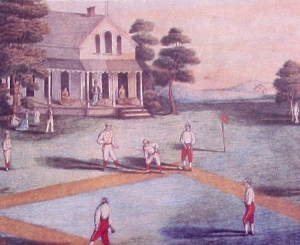
July 31, 2003 . . .Baseball is a great summer game in America, especially right here on Grand Island. According to Recreation Director Linda Tufillaro, besides Little League and Little League softball for girls, there are 65 adult softball teams currently playing. You’ll find teams playing here almost every day of the week, a Babe Ruth in every bunch.
Do folks think about Babe Ruth anymore, the homerun champ, the Sultan of Swat? Had he lived, George Herman (Babe) Ruth would have had his 108th birthday on February 6 of this year. The Babe died at the age of 53, a victim of cancer. Born in Baltimore, he hung around the saloon where his father worked, learning to curse and drink beer by the time he was seven. Undisciplined, he was sent to St. Mary’s Industrial School to learn a trade and to play baseball. With 800 students, there were 43 uniformed teams, and Ruth was a natural for the game.
He grew up to be over six feet tall with inky black hair, and because he was round-faced, rosy-cheeked and bright-eyed, he acquired his famous nickname. At 19 he started with the Baltimore Orioles as a pitcher, but soon proved he could swat the ball. The bat he used was the Louisville Slugger, and the Babe liked them heavier than most. He spent 22 years in the majors, hit a record 714 home runs, and became a national hero. He worked his salary up to $80,000 a year, more than any other player had earned up to that time.
The “Bambino” refused to follow team rules and curfews and got away with it because he could still hit the ball after carousing all night. The game was easier on the players in those days: leisurely travel by train between towns and no night games. Although Babe Ruth spent his money freely on such things as silk shirts by the dozen, he was persuaded to put away for a rainy day. He even bought a farm near Boston, stocking it with one of each: one cow, one horse, one pig and a few chickens. He bought a cigar factory and had his picture put on the paper cigar bands. He got married and somehow his wife put up with his lifestyle, including his aversion to underwear. He hated the long johns he had to wear as a kid, so gave up wearing underwear altogether as an adult. He liked late hours, good food, drinking beer, and talking baseball. He had a soft spot for kids, who popularized the Baby Ruth candy bar, mistakenly thinking it was made by their hero. Actually the candy was named 40 years earlier for Grover Cleveland’s new daughter.
Babe Ruth memorabilia is scarce and costly. A single 1933 Goudey Gum card in mint condition is worth more than $2500, and a baseball with an authenticated Babe Ruth autograph could be worth more than $3000. One thing Babe Ruth really wanted was to manage the Yankees. He never got the chance but he certainly earned his place in baseball history.
This year the American Folk Art Museum in New York City opened an exhibit titled, “A Perfect Game: America Looks at Baseball.” There are quilts and paintings and a great variety of baseball memorabilia. It runs until February 1, 2004, so if you are in New York, take a look.
Freedom Lost

July 3, 2003 . . .Grand Island is celebrating Independence Day in grand style this year, as usual, with the traditional road race and parade along Grand Island Boulevard. We’re free to celebrate the Fourth of July with as much holler and hoopla as we like. Free as birds. Freedom is a great American treasure.
I thought about the different kinds of freedom as I watched a pair of robins working in our yard. The birds that live on the Island and those just passing through are among our great treasures, too. That includes the barn swallows that build mud nests on the narrow beams under the planks on our dock. There are usually a dozen or so swooping about on pest patrol. But there is one less today.
It happened as I was tidying up the dock, getting ready for a holiday picnic. Earlier in the spring I had salvaged two old planks that had floated downriver and then got hung up on our pilings. I had fished them out and placed them on the dock to dry. I planned to use them as walkways in my vegetable garden or maybe to shore up the raised beds.
I dragged the smaller one away and then tackled the second one, longer and heavier and spongy in the middle. I walked it up on its end and then let it go, plop, one length closer to shore. Immediately came such a squawking and screeching that I knew I had caused a disturbance somewhere. The impact had startled one of the fledgling swallows nesting under the dock and she had fallen from her perch. The water was high and she may have misjudged its proximity or perhaps she simply fell into the river. She was swimming valiantly upstream, her wings too wet to fly. She flapped them vigorously, but just could not become airborne. She used her wings as oars to propel herself along, but lost ground, starting to come downriver with the current.
I grabbed my plastic bucket, hoping to scoop her up as she floated by. Instead, its appearance gave her renewed strength, and she turned, fighting her way up river once more. She tried persistently to reach dry land, only to come up against the steel seawall again and again. She would have to travel at least 600 feet up river before reaching a natural shoreline. How long could she stay afloat? Although birds have air-filled bones and buoyant feathers, only waterfowl have waterproof coats. I followed the bird with my bucket, tramping through the tall weeds, constantly peering over the edge of the wall, noting her progress, thinking I might still have a chance to rescue her. I saw her bobbing steadily along and then she disappeared around a bend. I scanned the water for a few minutes, but found no sign of her. Perhaps she had reached safety sooner than I had thought possible.
Back at our dock, her friends and neighbors were still sounding the alarm, flying every which way, crying out in dismay, to my mind, at least. I spotted a wee bit of the mud nest tucked just underneath the place where I had been working. Why hadn’t I been more careful? Hoping for the best I continued with my chores, watering the potted geraniums, sweeping the twigs from the deck and the old wood chips from the dock.
Maryan Traun - 10/24/09 to 6/24/03
By Ruth Stahl

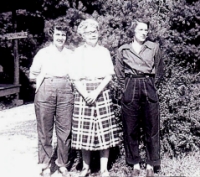
(Left) Maryan Traun on her 90th birthday; (Right) Girl Scout Leaders Maryan Traun, Lucy French and Eleanor Barker.
The following is an interview with Maryan Traun written by Ruth Stahl in October 1992 as a Golden Profile for the Island Dispatch.
"One time we took some Brownies on their first camping trip. They were all so homesick, theyhad to crawl into bed with the leaders for comfort. Beatrice Ashley, mother of Emery Ashley and Yvonne Martin, started Girl Scouts on the Island. I remember Teddy Klingel as one of the Scouts at Seven Hills," said Maryan Carver Traun, longtime Ferry Village resident.
"I was born in Erie, PA, where we lived until I was 16. We moved to Buffalo then and I graduated from Hutchinson High School. My dad worked on the ferry boats and the family moved to Ferry Village because there was a water system here. I worked for Sexton Photo Finishing, and then Carhart. Right after the war, I went to Bell Aerosystems and did photographic work there for 20 years," she said.
Maryan Traun has lived on the Island since 1935, except for eight years spent in Minneapolis. She married Marcus Traun, a flour miller, whose job took him there. Maryan still lives in Ferry Village. Her daughter, Marcia attended Sidway School where Mabel Leibinger taught her math. Maryan also raised Jay Gemboys for 12 years and is his legal guardian. "He's in the Navy now and calls me every week. He's a good kid. I'm very proud of him," she said.
Maryan is much involved with her church, Emmanuel United Methodist on Baseline Road. Her mother taught Sunday school when the church was in Ferry Village and known as the Chapel. Maryan enjoys the annaul peach festival at the church and always bakes fresh peach pies for that day. "One year, Helen Peck and I baked 32 pies. We had to use her truck to deliver them" she remembered.
One of the treasures of the Grand Island Historical Society is Maryan's wedding gown. It is white peau de soie, sleeveless, with a little shawl and a short ruffled train. The dress was very popular in the Society's fahions shows, but is quite fragile and is now retired. "I bought that dress at the Jenny Shop in Hotel Statler in 1935. I was married in my girlfriend's (Priscilla Faxon Learner) home on Elmwood Avenue. My two bridesmaids are still my closest friends. In fact, Priscilla has recently joined our historical society," noted Maryan.
She is a charter member of the Society as was her father.
"Hazel Link and I were in charge of the kitchen for the longest time. It's much improved now," she said. Another of her interests is gardening. "One year I planted 325 tomato plants because I wanted variety. I supplied all the neighbors and even had a little stand out in front for vegetables and flowers. Ruth Holden used to buy yellow tomatoes for her conserve," she recalled.
When Maryan sits down for a rest or a visit, you'll always find her with a cup of tea. In fact, her license plate reads, "Tea Time," a gift from her daughter.
"I love Ferry Village," she says. "There's quietness and a serenity here that you don't find elsewhere. And neighbors look out for each other."
It's a sure bet that Ferry Village feels the same way about Maryan Traun.
Editor's Note: Maryan Traun, who lived in the Ferry Village until only a few years ago, passed away on June 24, 2003. Memorial services will be held at 11:30 a.m. Saturday, June 28, 2003 in Emmanuel Community Bible Church, 1136 Baseline Rd.
Wilson Historical Society Country Fair
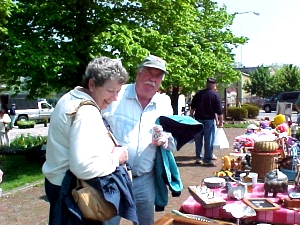
June 5, 2003 . . .Beverly and Jack Mikulski sure do get around. You see them above shopping at the annual Wilson Historical Society’s Country Fair, held every Memorial Day on the Historical Society Grounds. It’s not surprising that many Islanders find their way here. The Society’s only fund-raiser is supported by all of Niagara County. Although the weather was splendid this year, the estimated attendance was 15,000, down from last year’s 20,000. Perhaps it was the recent rains. Quite a few vendors were stuck in the mud at the bottom of the field and shopping there was difficult, to say the least. Tractors were called to pull them out.
The Wilson Historical Society was formed in 1972 and, according to Society president, Sally Smith, the fair was started the very next year, with donations from local residents. Activities center around their museum, an old restored railroad station. Every year something is added to the fair and the list of vendors grows. This year there were about 250, including yours truly, Kelly’s Country Store and former Islanders, Ruth and Russell Steinbring. I had a good spot near the road and along the sidewalk, high and dry with lots of customers. (I earned it after 25 years of faithful participation.) It was fun to watch the mounted police and hear them blow their whistles while controlling traffic. Parking was limited at the site so shuttle buses were provided from the center of town.
The people across from us were selling healthy-looking plants, both flowers and vegetables. I found some portulaca, which I had been looking for. I plant it in my spouse’s old boots for interest in the garden. Besides all the crafts and collectibles for sale, there were pony rides, a petting zoo, a climbing wall, a bouncing room, and the Mason’s doing child identifications. What’s a fair without food? You could choose from roast beef, hot dogs, funnel cakes, candy apples, cotton candy, doughnuts, kettle corn, fudge and Chiavetta’s chicken barbecue. You could also visit the museum in the railroad station, examine the restored schoolhouse and the Tugwell cabin, or take a chance on a beautiful hand-made quilt.
Entertainment included a talented pianist, Robert Hall, plus performances by local and school groups. Besides eating, I enjoyed visiting with friends who came along and checking out the variety of purchases that passed by. One woman pulled a coaster wagon heaped to overflowing. I saw a painted dining room chair with a hole cut in the seat for a plant and fake ivy trim---pretty gruesome. There were huge framed pictures, a school desk, tools, dolls and toys, and even a coffin hoist. Every breed of dog came to the fair and visitors wore an astounding variety of hats.
A friend was especially pleased to find some fisherman-themed fabric for the bathroom in her lodge. (She bought all my plastic ducks.) I also sold a Ginny doll, a coffee grinder, a quilt, and lots of little stuff that helped clean out the barn. I didn’t get much shopping done myself but maybe will on Labor Day, when a scaled-down version of the fair is sponsored by the Uxley church, on the same site. Try to make it.
Peaceful Plots
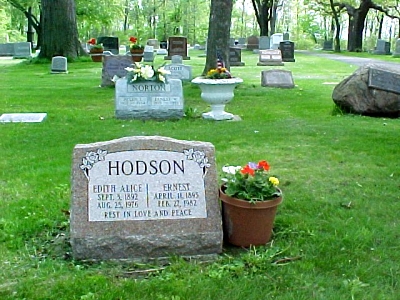
May 29, 2003 . . .Each spring we replant a large clay pot with flowers and place it next to Pop’s stone at Whitehaven Cemetery. Mother’s name is on the stone, too, but she’s not there. Pop buried her ashes somewhere at the old homestead and no one knows where. This year we put in a variety---geraniums, petunias, marigolds and Dusty Miller. Pop’s grave is so close to the road I can read the marker as I drive by, extending a silent greeting. We figured Pop would like being close to the road because, in later years, he enjoyed watching the daily traffic. And when he came to visit we always situated him in a comfortable chair at river’s edge, so that he could get a good look at the boats of summer.
Whitehaven Cemetery is a peaceful place alongside Spicer Creek at East River and Whitehaven Roads. Although Pop is a fairly recent inhabitant, there are some long-time residents here. One of my favorite stones is for Jane, who died in 1859 when she was just past 18 years old. Her family name is illegible and one can only speculate about the cause of her death. A flower is carved above her name and a verse inscribed beneath it: “All ye who come my grave to see, As I am now so must you be.” True enough.
The earliest grave appears to be that of Warren Kent, 1839, and his wife, 1828. There’s Captain Pettit who finally quit the boats on the river to operate a general store in Ferry Village. Here, too, lies a victim of murder. Was it an unsolved case, or just one that could not be proven?
Also resting at Whitehaven is the famous football player, Frank A. Hinkey (1870-1925). Hinkey was born and raised in Tonawanda but was buried in the family plot on Grand Island. At 127 pounds, he played end for Yale toward the close of the 19th century. Grantland Rice, dean of sportswriters, named Hinkey to the All-American football team, proclaiming him to be the very best. Could we bring him back for the Buffalo Bills?
The Maplegrove Cemetery on Stony Point Road is another small one, established in 1902. The Huling family donated the land to the “Old English” Congregational Church, which was located at Whitehaven Road and the Boulevard. The church was demolished to make way for the Boulevard. The parsonage, once the Whippy Dip and then a fish market, came down so that a gas station could be built on the spot.
Three of the oldest stones here are for George, Martha and Anna Huling, all young children who died in 1872, reportedly from diphtheria. They were buried in Whitehaven Cemetery but the Huling family moved the markers when the new cemetery was opened. Another resident is Mark Huling (1883-1951) who toured the country with his trained sea lions, Sharkey and Sandy. Mark used to exercise them in the Niagara River.
There is a tale about Ansley L. Dilliot (1891-1946) and his top hat, sworn to by several prominent citizens. It seems that he stepped out of Trinity Church one breezy Sunday morning, when the wind caught his top hat, tumbling it down the street. It stopped beneath a standing horse who happened to be relieving himself. With a flourish, Ansley retrieved his hat, shook it out, and placed it firmly on his head. They say he was bald within a month. Grand Island’s most famous military hero is also buried in Maplegrove Cemetery. Charles N. DeGlopper was awarded the Congressional Medal of Honor for courageous service in France in 1944, more than 50 years ago.
The smallest cemetery on the Island is the Staley family plot on West River Road. There are only three dozen stones here, including one hand-drawn on a block of cement. Each family branch has its own row, with the oldest stone dated 1852 for a member of the House family. According to the markers, some time along the way the spelling was changed from Staly to Staley.
The three other local cemeteries have their share of heroes and history, too. St. Stephens on Baseline and Trinity Cemetery on Whitehaven Road both date back to the middle of the 19th century. The Assumption Cemetery on Whitehaven near West River is a newer one.
But my favorite is that peaceful plot on East River Road. Once I found a single red rose at the base of that little weathered stone. Somebody had remembered Jane. I wonder who---
Antique Road Show At River Lea
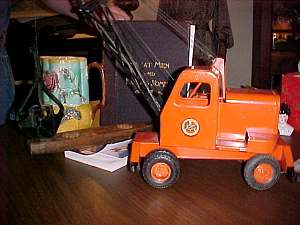
The most recent meeting of the Grand Island Historical Society was dubbed “Appraisal Night”, and although we didn’t have the high-class (and overpriced) stuff of the real Antique Road show, we had fun sharing our treasures.
We talked about the appraisers on that show being from top-of-the-line auction houses or upscale New England dealers. We mentioned that Western New York was an entirely different market and that condition and rarity are most important, along with provenance. When I first started collecting old stuff, the idea was to completely strip old furniture, sand it well, and apply a new “natural” finish. Today it’s deemed a sin to remove the old paint, no matter its condition. That makes it easier for everybody. Just sand it a bit to remove the loose flakes, apply a flat coat of sealer to keep the remaining paint in place, and, voila! You have a country treasure.
What about provenance? Provenance is defined as the origin or source and usually means the history of a particular piece. Member Jean Wholahan had a wonderful selection of old photographs, including an early tintype, and knew exactly who all her relatives were, even the couple riding a buggy pulled by an ostrich! We all vowed to identify the subjects in our own family photos.
Marcia Traun had a beautiful set of English Meakin porcelain, including ten butter pats and a large soup tureen with matching ladle. (She brought just two sample pieces.) Rose and Ed Kij had an unusual print of a water scene done by actor Lionel Barrymore, brother of John Barrymore. Maisie Dommell showed a small piece of carnival glass and a pretty beaded blue glass vase. Curt Nestark, president elect of the Society, brought a great all metal toy crane with bucket and original paint, made by the Charles Wm. Doekkpe Mfg. Co. of Rossmoyne, Ohio. It is a choice piece for toy collectors. (See above photo.)
Among the books offered was an early edition of Aesop’s Fables. Shirley Luther exhibited a wonderful set of books being deaccessioned from the Historical Society's Library. It is an eight volume, first edition, leather bound set issued in 1894 and titled “Great Men and Famous Women”. The books have beautiful end papers and include 126 wood engravings along with other illustrations. They cover soldiers and sailors, statesmen and sages, workmen and heroes, artists and authors. This wonderful set could be yours for a donation of $200 to the Society. (It lists at over $300 by rare book sellers.) They would look impressive on anyone’s bookshelf, and you might even read them! If interested contact Shirley Luther, Librarian. (The books are being sold because the library concentrates only on Grand Island history and related topics.)
From My Gardener’s Journal

April 24, 2003. . .In checking my gardener’s journal (just an ordinary notebook) I came to the conclusion that this April is not so bad after all. It’s just that we’re tired of a long, cold unbroken winter. On April 28, 2000 I wrote, “Raked leaves from the ivy along the driveway. It looks good but needs trimming.” Here it is only the 16th and I’ve done that job already. But in 2000 that day was warm and sunny with a temperature of 60 degrees. We’ve had only one of those days so far. The 29th of that year was another 60 degree day and I continued raking, noting that the magnolia tree was in full bloom. I doubt that we’ll meet that date this year unless we have some really warm days sometime soon.
On the 30th I reported the need to pot up some lemon balm, so it must have already sprouted. I removed the wire cages I had placed in the fall to keep the deer from eating the evergreens, storing them behind the garden shed. “Sunny but a cool wind," I wrote. I had done a bit of research on plants I needed to learn more about. Day lilies was one because we have the common tawny-orange variety that grows wild along roadways. They are close to the road and grow regardless of road salt, stones or lack of water. They are easy to grow and quick to multiply, not seeming to be bothered by deer, so I should plant more of them. Most blossoms last a single day but there are always more to come. Today there are wonderful new varieties available in many colors. I’ll look for those this year.
Another was rhubarb because my little patch is fading away rather than increasing in size. We are told to divide and separate in the spring. Dig holes 18” apart and put compost or fertilizer in each hole. (Rhubarb likes manure.) Place a single piece of root in each hole and cover with soil. Fertilize but do not harvest until the second year. Pull out and up, largest stalks first. Don’t eat the toxic leaves and do remove the seed pods. The more you harvest, the more the plant will produce. Perhaps the farmer’s market will have rhubarb roots for me. I enjoy stewed rhubarb and also strawberry rhubarb jam.
I was going to check on canna lilies but decided to abandon them because it was such a nuisance digging them up in the fall and replanting in the spring. I did read a little bit about chives, however, although they are familiar and not fussy. They can be started from seed but also divide easily. They make a nice ornamental border, especially if allowed to bloom. They should be clipped to ground level regularly to keep the spears from becoming tough. You can chop, dry and store them or freeze them fresh. We have enough chives around here to supply all the restaurants on Grand Island.
May 1st was a sad day. “We buried our little old dog, Skeezix, in the pine grove and placed a large birdhouse and a flag on his grave. Sootie, the bookstore cat, sat there awhile to pay his respects. Skee broke his chain last night and we searched for hours but couldn’t find him. He was hit by a car on East River. The dog catcher brought him home this morning. We loved that little dog and will miss him.” We lost Sootie last year but have Clancy now, another black cat, and Bailey, a black Lab. We need pets to love around here. I further noted on that day. “Soft rain today. Nice for Skeezix. Not cold.”
Will Winter Never End?
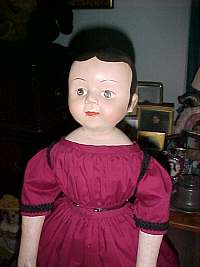
April 10, 2003. . .“Sesame” was the magic word because all of a sudden winter released its hold and I was able to open the doors of my back yard shed. There was no evidence of little critters having wintered there. Usually my roll of paper towels has been recycled for nesting materials, but everything was intact. I dragged out some empty pots to make more foot space, but that was the extent of my preparations for spring. I should have done more, because, when I checked yesterday, old man winter had jammed up the doors once again.
But there is increased activity outdoors, at least with wild life. Squirrels are seen scampering around, and there are more birds, although what they can find to eat with all the snow is a mystery. Friends Ruth and Fred Thompson spotted a flock of wild turkeys over on Stony Point Road and photographed them. "I’ve never seen that many together before,” Ruth said. She counted fifteen, so lets hope they stay on the Island. I saw one briefly years ago near my grapevines, but never a flock.
Anticipating sunshine, my spouse and I assembled one of those solar lights for the yard, and it actually glows at night, even after sunless days. You can’t say they supply free energy because there are batteries inside, but I like the concept. Will it be windmills next?
Last week’s ice storm just about did me in. After starting the car and chipping away at a half inch of ice all around, I stowed my belongings inside and then heard an ominous “click.” Yes, I had locked the car with the motor running and my spare key inside. I was already late for a doll-making workshop with the Grand Island Chicks and others, so my spouse offered to drive me. What good would that do? All my “stuff” was locked inside. We eventually called the AAA and a wee bit of a girl in a large truck arrived shortly to unlock the car. Not the best way to start the day.
Carolyn Doebert hosted the two-day workshop which involved seven of us trying to replicate Izannah Walker dolls made about 1873. The doll was patented that year but Walker was making them long before that. An original in mint condition goes for $18,000 and up, so you can see why we decided to make our own versions. Mrs. Walker lived in Central Falls, Rhode Island and made her dolls of stockinette, all cloth with applied ears, stitched fingers and applied thumbs. The hair and features of these large dolls, about 18 inches tall, were painted in oils. The tricky parts were shaping the nose, making the ears and thumbs and attaching them and stitching the little fingers. We all got that much done, plus putting on a coat of gesso as a foundation for the paint. Next comes skin tones, painting hair and features, assembling parts, making clothes and painting shoes. We worked two full days, but at least two more are needed. No wonder they cost so much!
When the post office issued doll stamps two years ago, one company copied the Izannah Walker doll to sell (see photo above—I found her on ebay). I wonder if some child on Grand Island in the 1800s ever had such a doll. Sometime soon, at least, there will be a couple of replicas here.
Open, Sesame!

Mar. 20, 2003. . .Put two warm sunny days together on Grand Island, and the result is miraculous. The first thing I did on St. Patrick’s Day was to fling open the bathroom window, and there, on my neighbor’s roof, was a perky spring robin. This afternoon I ventured out on the porch, sat down in a still-chilly rocker, and drank my coffee while enjoying the view. The river was calm with a few ducks breaking the surface. Later in the day a row of geese floated by, staying close to shore. A few small birds twittered in the trees.
But others were moving, too. All day long, we had our own St. Patrick’s Day parade on East River Road---roller bladers, cyclists, joggers, walkers, dog exercisers, and my favorite, a new mother pushing her baby buggy while she walked at a brisk pace.
There was not much work you could do outside, though. Ice and/or mud covered the ground and fallen branches to be gathered were still stuck in the snow. I haven’t trimmed my grape vines yet; perhaps I could have done that. I checked the new back patio which seemed to have weathered the winter all right, and tried again to get into my little shed. We have “his and her” sheds but I haven’t been able to open the doors on mine all winter. The new bricks rose up just enough to wedge the doors shut. It’s my hidey hole for all kinds of treasures---old picture frames, drying racks, bits of lumber, fence pickets, some old books, canning jars, a croquet set, the little chair my father made, a ton of baskets. It’s good mental exercise, just trying to remember the contents. I’ve forgotten some of the stuff and am anxious to see what’s there. How long will it take for the ground to thaw out and the bricks to sink to their original level? There is a big log in front too, the work of one winter storm, but I can hop over that.
We’ll have a lot of leaves to rake when the thaw finally gets here. Winter came so soon last year that we never finished that task And like everyone else, we have many twigs and branches to clean up. A Christmas wreath still hangs on the potting shed down at the waterfront, and a tub of garlands is waiting on the porch to be stored in the boathouse. I haven’t walked down to the river since Christmas to put those things away because the snow was so crusty and treacherous. Our warm weather may be short-lived, but at least, I have a good start on my to-do list!
Fun with Flowers in Filly

Click for larger view
March 20, 2003. . .Philadelphia, that is. Six Island friends (forever after to be known as the Grand Island Chicks) got together on a bus trip to the well-known Philadelphia Flower Show last weekend. We got off to a slow start. Although a limo had picked us up on time, we had to wait in the Home Depot parking lot for limos #2 and #3. One got stuck in the snow in Amherst. The tour company had a policy of transporting travelers door-to-door to the starting point of the tour. We don’t know who decided we couldn’t leave our cars at Home Depot, but it was a nuisance and meant an earlier start.
We were late then, picking up the bunch at Southgate Plaza, where we were to have orange juice and bagels. The orange juice was good, but somehow the bagel company never got the order. Enroute to Erie to get our final two passengers, the company treated us to breakfast at MacDonald’s. From then on it was smooth sailing. The day was cold and sunny, and maybe the flower show would give spring the impetus it needed.
Well into Pennsylvania, the snow cover was pristine, broken only by a few snowmobile trails. From the bus we got a good look into the leafless woods, with some idea of how Mother Nature does the winter pruning. Somewhere south of Dubois, Pa, the snow seemed to thin out, and here and there appeared a few streams of melted snow. Was it the latitude or the day’s continuous sunshine? To pass the time, we watched a sweet movie, “Return to Me”. Just past Harrisburg, Betty Clement pointed out that fields were bare of snow.
We were so late getting into Philadelphia that we had to go to our scheduled dinner before checking into the hotel. We were glad to hit the sack that night. Carolyn Doebert said I didn’t even snore! We had all day Saturday at the show, held at the convention center, close to our hotel. The main theme was tropical Costa Rica, so although the presentations were spectacular, the plantings did not really apply for our climate. We spent little time at the competition tables and headed early to shop the vendors.
Shopping is a part of any trip, and did we ever! Bamboo is big this year, so Lois Schoenfeld purchased shoots to take home. But flowers were too fussy to carry. We could have filled a truck with all the heavy stuff we really wanted---concrete troughs and statuary, garden gates and trellises, iron plant hangers, garden benches and more. Joan Staub managed to carry home some concrete frogs and Carolyn had her share of heavy stuff. There were books on gardening, repellents for deer and rodents, water gardens, garden paths----everything to excite the gardener. I bought a folding canvas bucket for toting weeds, etc. (It’s true that a bushel basket would work just as well.) My final purchase was a hinged wire plant holder or topiary frame. The bus driver called it a birdcage when he packed it in the bus. My spouse wanted to know, “Where’s the base?” (It’s the kind of thing you stick in the ground.)
We left the show early enough to squeeze in a 90 minute narrated tour of the city ($20 and well worth it). We saw all of the historic buildings and many of the over 100 murals painted to discourage graffiti. We were amazed at the crowds that filled the streets. We decided that Philadelphia was worth another visit. Our dinner at the Culinary Institute wasn’t much to brag about. On Sunday we visited DuPont’s Longwood Gardens where Doris Rees and I tried out the electric carts because the grounds were so extensive. On the way home we viewed “My Big Fat Greek Wedding”, appropriate, if only because of the little garden in the movie.
The trip lifted our spirits and the show got us in the mood for spring. But here we are back in Western New York---still in the midst of winter.
Day Trips; One, Good, Two, Not So
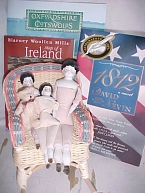
Click for larger view
If you used a compass to draw a circle with Grand Island in the center, extending 100 miles in every direction, you would discover a raft of destinations for fun, including our local waterways. Recently, we tried out three such trips.
One was to Toronto, on the perimeter of our curve. Joan Staub had a free ticket for two at the British Isles Canada show. What exactly was it? The web site didn’t say much, except to mention entertainment. We picked up Betty Clement and headed into Canada. We found the right building at the Exhibition grounds, paid the hefty $9.00 parking fee and went in to investigate. Lunch came first, though; we found British dishes on the menu. Betty chose cockaleekie soup; Joan and I tried “bangers and mash” (sausages with mashed potatoes and gravy). The food was good but the rest of the show consisted of venders selling souvenirs, a few travel agents and booths for a number of service organizations. The acoustics were poor, and a male singer added to the noise level. A lot of fans were lined up to get the autograph of a star from ”Coronation Street.” We bought some baked goods and left early. It was a long way to go for lunch.
The next day, Cousin Mona and I drove to Batavia for an advertised toy and doll auction. (We had attended the same annual affair last year and found it quite exciting, mostly because the Margaret Strong Museum had sent a number of discards.) This year was different. There were about six highly collectible dolls; the rest were modern and of little interest to us. Lots of guy stuff, however—tons of match box cars and rusty toy trucks and toy pistols. Not our cup of tea. We left early. Iron banks went for $50 and $170, a Shirley Temple Big-Little book, $25, a pedal car tractor with wagon, $65, German dolls, $220 and $260, early composition, $130, 170 and $430 for Scootles. Now, if you are wintering in St. Petersburg, Florida, the same auctioneer is running a button auction there on March 30 (2003) at the Radisson Inn. It’s button week-end in Florida and could be fun. Just a few that are listed include pearl, insect, zodiac, vest, enamels, porcelain, and horn buttons.
The one highlight in our three days of excursions was a visit to Fort Niagara to hear Ron Dale, superintendent of Canada’s Niagara National Historic Sites. He talked about the 1813 Battle of Fort George and the War of 1812 in general. He was entertaining and knowledgeable and looked smashing in his red-coated uniform. When asked why he had only one golden shoulder epaulet, he informed us that it was an indication of rank. He told us that the British were often criticized for wearing redcoats that were so visible, but the reason was to intimidate the enemy. Another tidbit was the information that Zebulon Pike, who discovered that famous peak, was killed in the battle at York (Toronto) during that war. It was a worthwhile experience, and so close to home.
Another event closer to home is the annual Zonta Antique Show, coming up this weekend at the River Oaks Club House. Early bird opening is on Friday, March 7th from 6 p.m. to 9 p.m., and on Saturday, March 8th, from 9 a.m. to 5 p.m.. If you can make it, come to support one of the Island’s oldest service organizations, and to see what’s current in the world of antiques. Unfortunately, I’m going farther afield to the Philadelphia Flower Show, so will miss it. Don’t you sometimes wish you were two persons?
The Valentine’s Day Fires
Feb. 20, 2003. . .The house pictured in our previous article (scroll down) was 2 ½ stories tall with dormers on the third floor and a large porch in front. Note the variety of sporting equipment displayed by the crowd on the porch: rifles, fishing rods and nets, oars, a high wheeler bike, tennis rackets and a few more, too obscure to identify. One woman is holding a baby and another, a banjo. Adults and children alike, they sport a good assortment of hats. Handwritten at the bottom of the matting are the words, ”Residence of J.A. Dingens, Red Top, Grand Island, N.Y. July 20, 1888.”
On February 13, 1943, just 60 years ago, that wonderful old house was set fire, burning to the ground sometime that night. “It was a beautiful house,” said neighbor Eleanor Campbell. “There were tennis courts and another porch in the back. It was the summer home of three sisters: Gene (Eugenia), Amy, and Louise Dingens. Gene was tall and thin. I think she was a dancer or an actress. Louise was stouter, and Amy was lovely, full of pep. Their father had operated a fancy grocery store on Delaware Avenue.”
On Valentine’s Day, 1943 the Buffalo Courier Express reported four mysterious fires on Grand Island. “Two Sheriff’s Deputies Narrowly Escape Death in Explosion: Two Homes Destroyed” were the headlines. All of the fires were within a mile of each other on East River Road near Staley. The homes were not occupied at the time.
The first fire was at the home of Miss Eugenia J. Dingens of 166 Park Street, Buffalo. The second, at 2106 East River was the summer home of Miss May Sickmon, 337 West Delevan Avenue, clerk of the federal district court. It was 6:45 P.M. when flames were first spotted at the Dingens home. At 10 P.M. the Sickmon home was reported ablaze. The Grand Island Fire Department, under the direction of Henry Ehde, Jr. and John Dilliot, Jr., worked on the fires but were hampered by strong winds, bitter cold, and the distance to the water supply in the river.
Fireman Irving Tinkle donned a gas mask, went into the Dingens home, and brought out a lighted oil lamp. The lampshade seemed to bear fresh fingerprints. Deputies Edward Amborski and Max Felerski narrowly escaped injury when an explosion occurred in the Sickmon home just as they were entering. The rear wall was blown out and all the windows shattered.
Mrs. Campbell remembered, “Everyone tried to help but it was impossible. They couldn’t get the water up the hill. I saw both houses burn. We just stood there and watched, frozen stiff. Teenagers set the fire and I think they got them. May Sickmon rebuilt her house, almost on the same spot.”
The two homes destroyed were only partly insured. Miss Dingens reported her home alone was worth about $10,000, not including the antique furniture that “cannot be relaced”.
Miss Sickmon said, on that occasion, “All our home needed to make it an all-purpose house was a heating unit. It had ten rooms and the house alone was worth $8500. We reported burglaries two weeks ago and two years ago. Whoever entered the place emptied every drawer and upset all the furniture. Tacks, soap chips and sugar were sprinkled all over the floor.”
That night burning rags were discovered in two one-story cottages nearby, owned by George Isaacs of North Putnam Street. Also a box of matches set over the chimney of a lighted oil lamp was found in a cottage owned by Leland Pfohl at 2012 East River. The place had been ransacked. (Now the home of Ed and Marcia Pfohl). A guard made up of state police, sheriff’s deputies and coastguardsmen was set up to patrol the entire island. On Monday, Feb. 15, the Buffalo News reported that two persons suspected of setting the fires and looting the homes were sought. Were they ever caught and convicted? Or are they still around on Grand Island, 60 years older, and maybe feeling guilty? By now they could be in their graves or tottering around on wobbly legs. It’s time for the guilty ones to confess and solve this old mystery.
More on the Dingens Diary, 1895
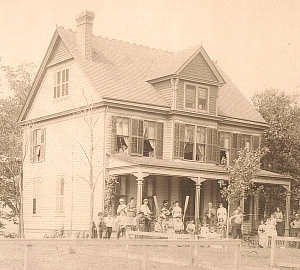
Click for larger view
Feb. 13, 2003. . . Above is a photo of Red Top provided by Islander Norm Bauman. In the late 1800s Joseph Dingens kept daily diaries in which he described the weather, the road conditions, and progress in fixing up Red Top, the family summer home at Staley and East River. He included reports of family activities in the city. He rarely mentions the ferries; I guess they were just a fact of life during those times.
Joseph Dingens seemed to use Delevan (Street) a lot and describes it often as muddy and rough, so perhaps it was not paved. He fished in May with little luck, and handyman Husley continued “sodding”. One day a friend found Husley “just awakened from a sleep in the barn and didn’t see him any more that day”.
It surprised me that the family store was open on Decoration Day, but considering that they sold gourmet provisions, maybe it was to be expected. In the evening Joseph went to the Main Street rink to see polo on skates. He was also involved in rehearsals for some kind of performance at the Academy of Music.
On June 4, 1885, Dingens started for Grand Island with a horse and wagon via the “upper ferry”. The roads were slippery. On that day a painter was staining woodwork in the back bedroom downstairs. Joseph painted the inside of the privy but unfortunately left the door and windows open, so the fresh paint was spotted by rain. The next day he puttied nail holes and John Connor, the painter, worked until noon. Joseph bought a bag of oats (three bushels) for Tucker the horse at 45 cents a bushel.
Now here’s a mystery. Joseph reports that he set Husley to work for the club, cleaning the grounds and cutting up fallen trees. It was nearby, so was it a family club? Norm Bauman helps us out again. Julia Dingens had deeded some property to the Cosmopolitan Club of Buffalo and it seems to be a social club with headquarters in the city. Joseph paid Husley $10.25 for the week, since he missed only one half day.
On June 30 two men with carpets called at 166 Park Street, the Dingens’ city home, to go to Red Top. “We took the sideboard down in the covered wagon. The carpets were finished by 4:30.” Sometime later Joseph paid the bill of $400 to a Mr. Morgan.
Now here’s something to look for: On July 1, 1885, Dingens received his final lot of the second edition of 500 cookbooks. Were they produced for customers of the store? I thought they might be small booklets given away, but Mr. Bauman tells us that they were volumes of more than 400 pages, so perhaps they were sold in the store. Norm actually has a copy, titled, “Cosmopolitan Cook and Recipe Book” dated 1882. He says it makes fascinating reading.
The next day two more loads of furniture arrived including two bedroom sets. It was not all work and no play for this family. On July 3 they watched the bicycle parade and then saw the bicycle races after dinner. Another excursion was on the steamer Perriwinkle around the Island.
St. Ives: Kits, Cats, Sacks and Wives

Jan. 23, 2003. . .The old nursery rhyme goes like this:
“As I was going to St. Ives, I met a man with seven wives;
Each wife had seven sacks; Each sack had seven cats;
Each cat had seven kits. Kits, cats, sacks and wives,
How many were there going to St. Ives?”
St. Ives is a picturesque old fishing village on the Atlantic coast of Cornwall, England, and on a recent trip we did not see many sacks, but there were wives and certainly cats. The cats sat on garden walls and sidewalks, and peered out of lace-curtained windows. And the locals seemed to love them, almost all passersby stopped to greet a cat. These were not like the wild cats of Rome, but domesticated and very well behaved.
St. Ives got its name from a 6th century missionary, St. Ia, who “sailed from Ireland on an ivy leaf”. It’s an uphill-downhill town, with five sandy beaches at the bottom, and buildings working their way up to the top of the hill. In the old days it was two communities: Downalong at the bottom where the fishing families lived, and Upalong at the top where miners were housed. It later became an artist’s colony, attracting many famous artists as well as writers such as Virginia Woolf and Rosamunde Pilcher. Today it is a favored tourist attraction.
We were told it would be wise to stop at the Park and Ride at the local railroad station and take the train to the town center. We tried to do that but just missed a train and were persuaded by a passing bicyclist that we could drive into town and find parking at the depot. Wrong! The depot parking lot was jammed full, and we had to carefully back out to seek a spot elsewhere. We wound our way upwards on the narrow streets and found a lot at the top. Stairs and ramps brought us back down to the center of town. It was October, but still the streets were full of visitors, shopping in the souvenir stores. Not our cup of tea—we were looking for older stuff.
One find was a little odds and ends shop. The proprietor told me it was a shoe store during the season, which accounted for the temporary look of the place. There I found seven pieces of old handmade dollhouse furniture, nicely crafted and with a fine finish. The lot included two settle benches, a dresser, a table and three chairs. It all added up to 31 pounds but I got it for 20, about 32 U.S. dollars.
We continued down through the narrow streets to the shore where surfers were riding the Atlantic waves and dog owners were exercising their pets. They all ignored the signs that said, “No dogs allowed”. We stopped for soup and French bread at a tiny tea shop and visited the way-out exhibit at the Tate St. Ives gallery. On our way back to our uphill parking lot, we came upon a familiar sight—a library book sale! Our time for browsing was short, but I did manage to find a volume about thatched roofs: history, techniques and extant examples. As I doled out my British change, the clerk smilingly took whatever I had, somewhat short of the one pound asking price.
Which brings to mind our own library book sale, coming up on March 28 and 29th (2003). Remember to drop off your discards at the library during regular hours, and mark your calendars so that you can replace them with more. You might even find a book about thatched roofs, although they are not quite suitable for our snowy winter this year.
Red Top Plus The Two-Headed Calf
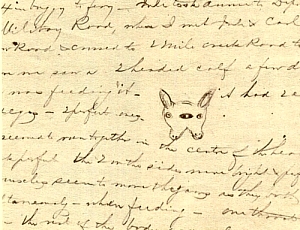
Click for larger view
Jan. 23, 2003. . .Islander Norm Bauman came to our rescue regarding last week’s story. He is a history buff and knows all about Red Top. “J. A. Dingens was Joseph Dingens who lived at 168 Park Street in Buffalo. He was a purveyor of high quality and gourmet foods. He owned the farmhouse at East River and Staley Roads called Red Top. His brother John had property on the outskirts of Buffalo, now Dingens Street, so that’s probably how it got its name. The Island property was put in the name of Joseph’s wife, Julia. They had daughters Aimie, Mammie born in 1862, Eugenia born in 1868 and Lonia born in 1880. Louis Keifer was a male servant. One hired hand is said to have been buried somewhere on the property. "The house burned down in 1942," said Norm. He knew nothing about the vault Dingens was building. Thanks to Norm for all that information. He promises a photo of Red Top soon.
We continue with notes from the 1885 diary. “I walked to Military Road where I met Indi and Carl, drove to New Road and crossed Two Mile Creek Road to Kaiser’s where we saw a two-headed calf, a few days old. Mrs. Kaiser was feeding it.”
The calf had two ears, two snouts, four eyes---two perfect, only the other two seemed to run together in the center of the head. The two on the sides were bright and perfect. One set of muscles seemed to move the jaws, as they both moved simultaneously. It had one throat, but two tongues, the rest of the body as usual. It seemed weak and could not stand up, appearing that the head was too heavy for the strength of the body. I doubt if it will live.”
“Reached home at 6:30. The road on the river was very rough. I picked up a fine jack knife on Two Mile Creek Road near the fence wet spots.”
Joseph Dingens had quite an eventful time on that day in 1885. We’ll explore his diary again soon.
Fixing up Red Top in 1885
Jan. 16, 2003. . .“On our first visit to Red Top on Grand Island, we took the n/c railroad to Tonawanda and hired a cutter for $1.00 to cross the river. There was lots of ice and snow but we found everything all right.” That was the entry made in the diary of J.A. Dingens of Buffalo early in 1885. By reading between the lines we determined that the Dingens family had some kind of retail business in the city and also owned property on the Island, which they called Red Top. We don’t know if that was an original name or whether the family newly created it. The diary belongs to the Buffalo and Erie County Historical Society and is in fragile condition, written in pencil on poor quality paper. The writing is sometimes hard to decipher. We wondered if Dingens Street in Buffalo had any connection to this family. Perhaps an old Island map will turn up something.
The second visit took place in April. Dingens had to break the dining room window to get in because the bolt at the front door was bent. The snow was all gone but there was thick ice in the cistern. The third visit came on May 3, 1885 and the writer mentions driving down Upper Ferry and back on Military Road. He walked from the railroad bridge to the Scajacquada Creek bridge. He doesn’t mention the ferry but he must have taken it.
“I found about two inches of water in the cellar and told Husley to pump it out, to clean the cistern and the grove.” (Husley turns out to be a hired hand.) The fourth visit occurred just 11 days later, so the weather was improving. Dingens drove down Delevan Street and mentioned that the road was good most of the way. “Found Husley in the barn. He reported working 3 ½ days the previous week. I patched the bottom of the boat with copper strips.”
May 15 was a big day, a fine day, although foggy in the morning. He arrived with friends and lots of stuff---pictures, bone dust (?), grass seed, and “Annie the hired girl to clean the house and stay til tomorrow. Plastering. Husley and I put in the light of glass which I broke to get in the house on the second visit.” On May 16 lumber was delivered and Annie continued cleaning house.
“Set Husley to work on the grounds digging for the vault. (Could this have been an outhouse?) I built the vault until 4 P.M. when we all started home to the ferry. Indi took Annie to the depot.”
Things are beginning to shape up. Will the house be ready by Decoration Day? Next time, read about Mrs. Kaiser’s two-headed cow.
Behind Closed Doors

Jan. 2, 2003. . .Driving around the Island in warm weather, down Baseline, up Stony Point, through Sandy Beach and Ferry Village, reveals a lot about the contents of local garages. A few are neat and orderly with room for a car or two, but most are stuffed to the ceiling, probably never having housed an automobile. It makes us feel better because we are in the same boat.
You may see a few open garage doors in January as folks move snow blowers in and out or transport garbage to the curb, but for the most part they are sealed up tight. What better time to take an inventory of contents? If you do it in the summer people think you are having a sale; in the winter you can work without interruption.
I undertook the task because I’ve been wanting a used golf cart to drive around the yard, but it would have to be stored undercover in the garage. Our garage has the usual essentials----garden tractor, snow blower, mulcher, and a big corner for garden tools. We have six cat carriers although right now, only two cats. There’s my little workbench, now piled high with a year’s supply of paper towels and toilet tissue. (Not MY purchase.) My spouse has several benches loaded with tools and a couple of tool cabinets. Still, there ought to be room for a golf cart. What else is taking up space? Let me count the ways. We have four vacuum cleaners plus an electric sweeper, in addition to the ones we actually use in the house. There are ten or twenty shop lights meant for the basement and the old back door we replaced three years ago, plus a lot of scrap lumber and some folding tables.
I found the rubber-backed runner we need on the porch because it gets very slippery now that it has been freshly painted. We have an assortment of furniture clamps, berry baskets and hard hats, two treadmills, several coolers and a mattress for the old truck we used to own. We’d have a lot more room if we discarded all the empty boxes, gallon jugs and saved cans, although the latter are handy for paint jobs. I found several fire extinguishers (essential) and three typewriters (non-essential). Mops are hanging in one corner, far more than I need or use, except for the two Websters, one for inside and one for outside on the porch, great for knocking down spider webs. Below the mops is an old round wire folding laundry cart, too ingenuous to discard. It might work out in the yard as garden architecture.
A box of antique picture frames sits on top of the pile, along with shelf brackets, safety gates and a toboggan. Five folding cots hang on the wall. Underneath it all I know there is a brand new table saw and a reliable old jig saw, both of which I would love to use. That’s part of our January garage inventory. Do we need all this stuff? I haven’t made a formal resolution, but I plan to do something about it in 2003. What’s in YOUR garage?
